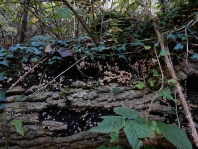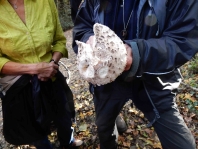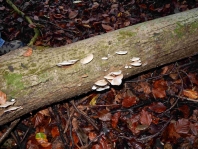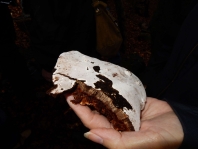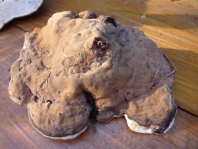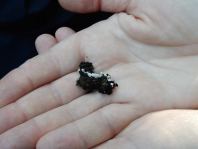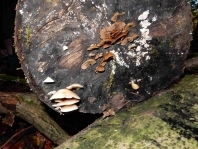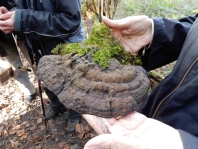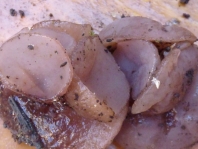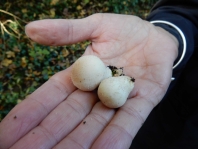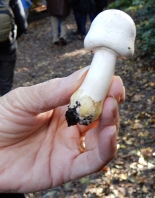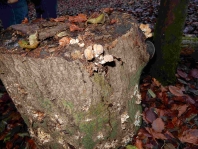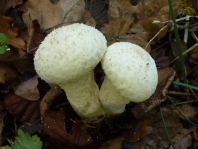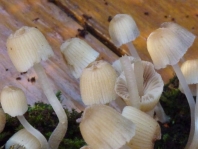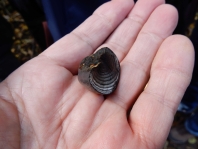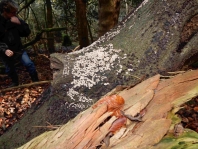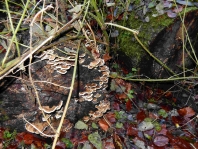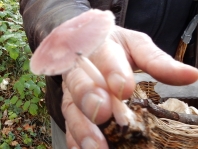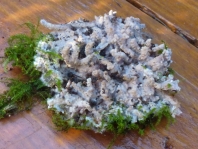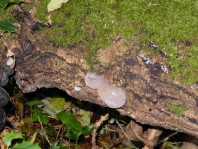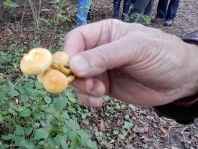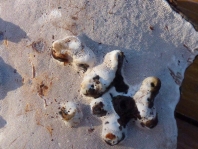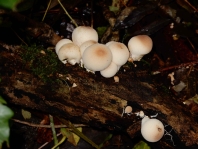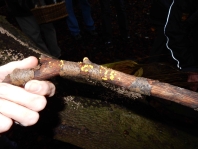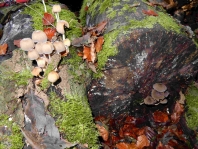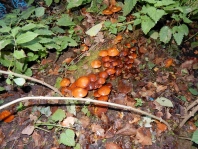Species
|
|
Description
|
|
Status
|
Edibility
|
Image
|
Agaricus xanthodermus
|
Yellow staining mushroom
|
very obvious yellow on scratching stem base, gills greyish-brown, carbolic smell, esp. when cooking
|
|
*
|
P
|
9
|
Ampulloclitocybe (Clitocybe) clavipes
|
Club foot
|
pale brown cap, decurrent gills, swollen stem base (foot)
|
|
C
|
*
|
—
|
Annulohypoxylon (Hypoxylon) multiforme
|
|
raised black hard lumps, often elongate, mostly on birch
|
|
O
|
*
|
—
|
Armillaria mellea
|
Honey fungus
|
very variable, tawny, whitish gills, white spores, ring on stem. Spreads via black "bootlaces" (rhizomorphs)6 strains recognised.
Here only black bootlaces found, encircling fallen trunk below the bark
|
|
C
|
*
|
—
|
Ascocoryne sarcoides
|
|
deep violet, often convoluted small ,solid soft discs, mainly on fallen beech.
Here in crack on fallen trunk
|
|
C
|
*
|
—
|
Bjerkandera adusta
|
|
thin bracket with grey pores
|
|
C
|
*
|
—
|
Calocera cornea
|
|
small gold (mainly) 'fingers' with unbranched tips on deciduous stumps
|
|
C
|
*
|
—
|
Chlorophyllum (Macrolepiota) rhacodes
|
Shaggy parasol
|
grows under trees, moveable ring, flesh reddens when cut or bruised. Can be digestive irritant to some
|
|
C
|
E
|
7
|
Coprinellus (Coprinus) disseminatus
|
Fairy bonnets
|
tiny, greyish caps in clumps on rotting stumps
|
|
*
|
*
|
1, 27 close up
|
Coprinellus (Coprinus) micaceus
|
Glistening inkcap
|
small tan caps, with glistening particles, in tufts on wood
|
|
C
|
*
|
15, 18
|
Crepidotus cesatii/variabilis
|
|
very similar macro features. Species need to be differentiated by spore examination
|
|
*
|
*
|
—
|
Crepidotus mollis
|
'Peeling Oysterling'
|
soft creamy-brown 'shells' on dead wood, elastic cap skin peels off.
Here on fallen Beech trunk
|
|
C
|
*
|
13 probably
|
Dacrymyces stillatus
|
Jelly spot
|
small yellow to orange blobs on barkless fallen timber
|
|
C
|
*
|
12
|
Daldinia concentrica
|
King Alfred's cakes;
Cramp balls
|
hard crumbly brown to black balls on dead ash, diff. species on other hosts. Works as a tinder
|
|
C
|
*
|
5 young material, brown
4 mature, black
|
Delicatula integrella
|
|
tiny white, with very primitive, decurrent gills, on soil, damp areas nr. Willow and Alder
|
|
U
|
*
|
8
|
Ganoderma applanatum
|
Artist's fungus
|
tubes in distinct layers, rarely with nipple-shaped galls of fungus fly on pores, white streaks in flesh, mainly BL wood, spores
smaller than G. adspersum.
See additional note
|
|
O
|
*
|
25 upper surface
20 upper surface of old fungus
19 lower surface
29 lower surface with pores showing exit holes of gall fly larvae
|
Ganoderma australe (adspersum)
|
an artist's fungus
|
brown thick bracket,no white streaks in context (flesh)
|
|
C
|
*
|
—
|
Gymnopus (Collybia) dryophilus
|
|
light tan cap dark centre, even, whitish gills, reddish typical fibrous stem
|
|
C
|
*
|
—
|
Hebeloma crustuliniforme
|
Poison pie;
Fairy cakes
|
brownish cap, clay-coloured gills, smell of radish
|
|
C
|
P
|
—
|
Hypholoma fasciculare
|
Sulphur tuft
|
grows on stumps in profusion, sulphur-coloured gills darken as purplish spores mature
|
|
C
|
P
|
23
|
Hypoxylon fragiforme
|
|
small hard balls, often in rows on dead beech, red going black
|
|
C
|
*
|
—
|
Inocybe lilacina
|
|
lilac- capped version of Inocybe. geophylla.often as pathsides
|
|
C
|
P
|
—
|
Kuehneromyces mutabilis
|
|
golden-brown viscous caps,margins drying paler; grows in tufts on stumps(can be confused with very poisonous Galerina marginata).
Here in poor condition
|
|
C
|
*
|
24
|
Laccaria laccata
|
Deceiver
|
pinky-rose-brown, 3 different gill lengths; very variable
|
|
C
|
E
|
17 probably
|
Lactarius subdulcis
|
|
tawny to brown cap, milk remains white on drying, esp. under beech. taste of ivy!
|
|
C
|
*
|
—
|
Lycoperdon perlatum
|
Puffball
|
small white puffball,grows in leaf litter, small "pearls" rub off.
Here some lovely fresh specimens
|
|
C
|
E
|
21
|
Lycoperdon pyriforme
|
Puffball
|
tan, pear-shaped puffball, branched mycelial cords at base, grows on wood
|
|
C
|
*
|
3, 6
|
Marasmiellus ramealis
|
|
small delicate, tan cap, sparse gills often on bramble stems, also twigs etc.
|
|
C
|
*
|
—
|
Mycena arcangeliana (oortiana)
|
|
yellowish, long stems with lilac tints; strong smell of iodoform when dry; decid woodland litter and stumps
|
|
U
|
*
|
—
|
Mycena galericulata
|
Bonnet mycena
|
quite large for a bonnet cap, tan colour, gills often interlinked at lower cap surface, grows on wood
|
|
C
|
*
|
—
|
Mycena pura
|
Lilac mycena
|
Medium sized, pink to lilac cap, stem in BL[often beech] litter, smell of radish
|
|
C
|
P
|
22
|
Mycena sp.
|
|
impossible to identify beyond genus level
|
|
*
|
*
|
—
|
Mycena vitilis
|
'snapping bonnet'
|
small bonnet cap, pale greyish-brown, "whippy" stem (unusual for this genus, most are fragile)
|
|
C
|
*
|
—
|
Myxomycete sp.
|
|
A slime mould, not a fungus.
When examined later already at the next stage where the little ball fuse to form the fruiting stage
|
|
C
|
*
|
—
|
Neobulgaria pura
|
|
pale pink-lilac crowded jelly buttons on fallen beech
|
|
C
|
*
|
11, 26
|
Peziza micropus
|
a cup fungus
|
small tan species, small stem usually present, this is the species found on rotten wood
|
|
*
|
*
|
—
|
Psathyrella sp.
|
|
large group all with silky brittle whitish stems, dark gills. Cannot be identified further 'in the field'
|
|
C
|
*
|
—
|
Rhodocollybia (Collybia) maculata
|
Foxy spot
|
quite robust, creamy, with red-brown spotting on cap and gills, fibrous stem, in leaf litter can grow in rings
|
|
C
|
*
|
—
|
Rhytisma acerinum
|
Tar spot
|
black patches on (mainly)sycamore, a discomycete
|
|
C
|
*
|
—
|
Sebacina incrustans
|
|
encrusting resupinate often,grows over bare soil and plant remains to form creamy patches, waxy.
Here in moss on decayed fallen BL tree
|
|
U
|
*
|
28
|
Sebacina incrustans
|
Hairy stereum
|
thin overlapping bracket, smooth golden (lower) fertile surface
|
|
C
|
*
|
—
|
Trametes (Coriolus) versicolor
|
Many-coloured bracket;
Turkey tails thin bracket
|
creamy pores, grows in tiers on dead wood.
Here old, lacking attractive bright colour bands
|
|
C
|
*
|
16
|
Trochila ilicina
|
|
Discomycete. Black dots growing on underside of Holly leaves
|
|
*
|
*
|
—
|
Tubaria furfuracea
|
|
small cinnamon striate cap, cinnamon gills (decurrent) and stem, mainly on woody debris
|
|
C
|
*
|
—
|
Xylaria hypoxylon
|
Candle-snuff fungus
|
small black branches with grey tips, on dead wood, often stumps
|
|
C
|
*
|
—
|
Unidentified
|
|
included above, but images too indistinct to differentiate
|
|
|
|
2, 10, 14
|
